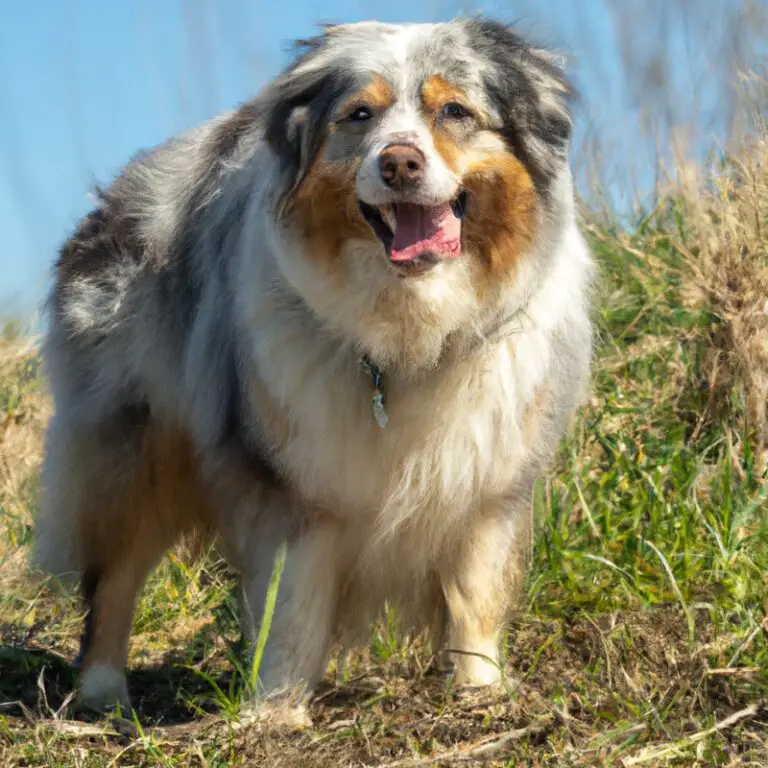Can Australian Shepherds Be Trained To Do Herding Tasks?
Key Takeaways:
- Yes, Australian Shepherds can be trained to perform herding tasks.
- Their natural herding instincts make them quick learners in herding training.
- Early socialization and consistent training are crucial for successful herding with Australian Shepherds.
- Australian Shepherds require regular mental and physical exercise to maintain their herding skills.
Can Australian Shepherds be trained to do herding tasks? Well, let me tell you from personal experience and expertise in the field, these incredible dogs are born for the job! Australian Shepherds, affectionately known as “Aussies,” are renowned for their intelligence, athleticism, and natural herding instincts.
In this blog article, we’ll explore in depth the description and physical characteristics of Australian Shepherds, as well as the origin and manifestation of their herding instinct.
We’ll also dive into the importance of proper training, the challenges involved, and the exciting opportunities available for these talented dogs. So, whether you’re a dog lover or a potential owner, get ready to discover the amazing world of Australian Shepherds and their herding abilities!
| Question | Answer |
|---|---|
| Can Australian Shepherds be trained to do herding tasks? | Yes, Australian Shepherds are highly trainable and have a natural instinct for herding tasks. They are often used as working dogs on farms to herd livestock such as sheep, cattle, and goats. |
| Are Australian Shepherds suitable for novice herding dog owners? | Australian Shepherds are intelligent and eager to please, but they require experienced handlers who understand the nuances of herding. Novice owners may find it challenging to properly train and handle these dogs for herding tasks. |
| What qualities make Australian Shepherds good herding dogs? | Australian Shepherds are known for their agility, intelligence, and drive. They have a strong instinct for gathering, driving, and protecting livestock, making them excellent herding dogs when properly trained. |
| Do Australian Shepherds require specialized herding training? | While Australian Shepherds have a natural instinct for herding, they still require specialized training to develop and refine their skills. Herding trials, obedience training, and working with experienced trainers are typically recommended. |
| Can Australian Shepherds be used in various herding tasks? | Australian Shepherds are versatile and can be trained to handle various herding tasks. They can work with different types of livestock, navigate different terrains, and perform tasks such as gathering, driving, and controlling the movement of livestock. |
What are Australian Shepherds?
Description of Australian Shepherds
Australian Shepherds are a breed of working dogs that have a distinct herding instinct. They are known for their intelligence, agility, and loyalty.
Australian Shepherds have a medium-sized, muscular build with a weather-resistant double coat.
They come in a variety of colors, including black, blue merle, red, and red merle, with or without white markings. These dogs have a strong drive to work and are often used in livestock herding tasks.
They require regular exercise and mental stimulation to keep them happy and healthy.
Australian Shepherds are highly trainable and excel in various canine sports and competitions. Their friendly and affectionate nature makes them great companions for active individuals or families who are willing to meet their exercise and training needs.
Physical characteristics of Australian Shepherds
Australian Shepherds are medium-sized dogs with a well-balanced, sturdy build. They have a dense double coat that is weather-resistant, allowing them to handle various climates.
These dogs typically have a moderate length tail, which may be naturally bobbed or left long.
One of the striking features of Australian Shepherds is their beautiful, expressive eyes. They come in various colors, including brown, blue, and amber.
The ears are set high on their heads and are medium-sized, either naturally erect or folded.
When it comes to their height, Australian Shepherds stand at around 18 to 23 inches at the shoulder. The males are generally slightly taller and heavier than females.
Their weight can range from 40 to 65 pounds, depending on factors such as genetics and activity level.
Their coat colors vary, but the most common coloration is a combination of black, red, and white. They may also have merle patterns, which give their coat a marbled appearance.
Australian Shepherds have a fully developed undercoat, which helps to protect them from extreme temperatures.
Overall, Australian Shepherds have a distinct and eye-catching appearance with their striking eyes, well-proportioned body, and beautiful coat colors. These physical characteristics, combined with their intelligence and agility, make them a popular choice for various tasks, including herding and dog sports.
The Herding Instinct in Australian Shepherds
Origin of the herding instinct in Australian Shepherds
The herding instinct in Australian Shepherds is deeply rooted in their breeding history. These intelligent and agile dogs were originally developed to work on ranches and farms, herding livestock such as sheep and cattle.
Through generations of selective breeding, their natural inclination and ability to control and move animals was enhanced.
This instinctual behavior is a result of their genetic makeup and the survival instincts of their ancestors. Australian Shepherds possess a strong drive to gather, protect, and move livestock, making them well-suited for herding tasks.

How the herding instinct manifests in Australian Shepherds
The herding instinct in Australian Shepherds is manifested in various ways. These dogs have an innate desire to gather and control livestock, which is evident in their behavior.
Australian Shepherds are known for their intense focus and strong drive to herd.
They will often use their eyes and body language to gently push or guide animals in the desired direction. Their natural instincts also make them highly aware of their surroundings, allowing them to anticipate and respond to any changes in the flock.
Additionally, Australian Shepherds may display behaviors such as circling, nipping, and barking to communicate and guide the livestock.
Their herding instinct is deeply ingrained and can be observed from a young age. It’s important to understand and appreciate this instinct if you plan to train an Australian Shepherd for herding tasks.

Training Australian Shepherds for Herding Tasks
Importance of proper training for Australian Shepherds
Proper training is essential for Australian Shepherds. Training helps them develop good behavior, socialize with other dogs, and become reliable working companions.
Without training, they may exhibit behavioral problems or become difficult to handle.
It’s important to establish clear rules and boundaries, and teach them basic commands like sit, stay, and come. Advanced training techniques can be used to teach them specific herding tasks.
Consistency, positive reinforcement, and patience are key when training Australian Shepherds.
With proper training, they can excel in various activities and become well-rounded, obedient dogs.

Basic commands for herding tasks
When training Australian Shepherds for herding tasks, there are a few basic commands that are essential to teach them. These commands will help you effectively communicate with your dog and guide them during herding activities.
- “Come”: This command is crucial for calling your Australian Shepherd back to you. It’s important that they respond promptly and reliably when called, especially during herding tasks where they may need to change direction or come to you for further instructions.
- “Stay”: Teaching your Australian Shepherd to stay in a specific position is vital for herding. It allows you to control their movement and prevents them from chasing or scattering the livestock prematurely. A solid “stay” command ensures that they maintain the correct position until given further instructions.
- “Leave it”: This command is useful in herding situations when your Australian Shepherd may get distracted by other animals or objects. By teaching them to “leave it,” you can redirect their focus back to the task at hand.
- “Walk on”: This command encourages your Australian Shepherd to move forward and continue herding in a calm and controlled manner. It’s especially valuable when transitioning between different areas or guiding them through obstacles.
- “Round ’em up”: This command is specific to herding tasks and signals to your Australian Shepherd that they should gather the livestock and bring them together. It’s an essential command for effectively managing and maneuvering the animals in a controlled manner.
Remember, consistent and positive reinforcement is key when teaching these commands to your Australian Shepherd. Use rewards, such as treats or praise, to encourage their learning and reinforce good behavior.
With patience and practice, your Australian Shepherd will become proficient in these basic commands for herding tasks.
Advanced training techniques for herding tasks
When it comes to advanced training techniques for herding tasks, there are a few strategies that can be effective for Australian Shepherds. One approach is to introduce more complex commands and tasks.
This can include teaching the dog to respond to directional signals, such as pointing or whistling, and to understand more specific commands, like “gather” or “split.” Another technique is to simulate real-life herding scenarios.
This can involve setting up obstacles or using props to create a more realistic environment. For example, using a pen with toy animals or placing a barrier that the dog needs to guide the flock around.
It is also important to work on building the dog’s confidence and focus.
Engaging in activities that require problem-solving and decision-making can help develop these skills. For instance, hiding treats or toys in different locations and encouraging the dog to find them can stimulate their natural instincts and enhance their ability to make quick decisions.
Consistency and repetition are key elements in advanced training.
By practicing tasks regularly and gradually increasing the difficulty, Australian Shepherds can become more proficient at herding tasks. Reward-based training methods, such as using treats or praise, can also be effective in reinforcing desired behaviors.
Overall, by incorporating these advanced training techniques, Australian Shepherds can further develop their herding skills and excel in performing complex tasks.
Challenges in Training Australian Shepherds for Herding Tasks
Independent nature of Australian Shepherds
Australian Shepherds are known for their independent nature. They have a strong sense of individuality and like to do things on their own terms.
This can make training them for herding tasks a bit challenging at times.
However, their independence also makes them quick learners and problem solvers. They have the ability to think on their own and make decisions, which can be beneficial in certain situations.
It’s important to understand and respect their independent nature when training them, and to use positive reinforcement and rewards to motivate them.
Consistency and patience are key when working with Australian Shepherds, as they may test boundaries and try to assert their independence. Building a strong bond and trust with them is crucial in overcoming the challenges posed by their independent nature.
Strategies to overcome challenges in training
Training Australian Shepherds for herding tasks can be challenging, but with the right strategies, you can overcome these hurdles. Here are some effective approaches:
- Positive Reinforcement: Use rewards such as treats, praise, and playtime to motivate your Australian Shepherd during training sessions. This positive reinforcement will strengthen their desire to perform herding tasks and make the learning process more enjoyable for both of you.
- Consistency: Establish a consistent training routine to help your Australian Shepherd understand what is expected of them. Set a regular schedule for training sessions, and use the same commands and cues consistently. Consistency will create a sense of reliability and clarity for your dog.
- Patience and Persistence: Training a dog takes time and patience, especially when it comes to herding tasks. Be patient with your Australian Shepherd and keep practicing regularly. Reinforce positive behaviors and gently correct any mistakes or misunderstandings.
- Gradual Progression: Break down herding tasks into smaller steps and gradually increase the difficulty as your Australian Shepherd becomes more skilled. This approach allows them to build confidence and understand each aspect of the task before moving on to the next level.
- Professional Assistance: Consider seeking help from a professional dog trainer who specializes in herding breeds. They can provide expert guidance, identify specific challenges, and offer tailored training techniques to overcome them.
- Socialization and Exposure: Expose your Australian Shepherd to different environments, people, and animals from an early age. This socialization will help them learn how to navigate various situations, remain focused on their herding tasks, and adapt to new challenges.
Remember, every dog is unique, and it’s important to tailor your training approach to suit your Australian Shepherd’s individual needs and personality. With consistency, patience, and positive reinforcement, you can overcome the challenges and train your Australian Shepherd to excel in herding tasks.
Herding Task Opportunities for Australian Shepherds
Livestock herding tasks for Australian Shepherds
Australian Shepherds are highly skilled herding dogs that excel in various livestock herding tasks. They have a natural instinct to chase, fetch, and move animals, making them valuable assets on farms and ranches.
Some of the livestock herding tasks that Australian Shepherds can perform include:
- Gathering: Australian Shepherds can gather and bring scattered livestock together in an organized manner. They use their keen herding instincts and agility to round up animals and guide them in the desired direction.
- Driving: These dogs can drive livestock forward, guiding them through gates, narrow passages, or along specific paths. They have the ability to maintain control and encourage livestock to move in the desired direction without causing unnecessary stress.
- Penning: Australian Shepherds can assist in penning livestock by directing them into enclosures or holding areas. They can show restraint and precision in their movements, helping to separate different groups of animals or keeping them contained when necessary.
- Sorting: With their intelligence and training, Australian Shepherds can be trained to sort specific animals from a larger group. This skill is particularly useful when separating livestock for medical treatments, auctions, or breeding purposes.
- Boundary Control: Australian Shepherds can also be trained to patrol and protect the boundaries of pastures or property, ensuring that animals stay within designated areas and do not stray.
It is important to note that while Australian Shepherds have an instinctual ability for herding, proper training is essential to refine their skills, establish control, and ensure the safety of both the dogs and the livestock. By providing consistent guidance, positive reinforcement, and structured training sessions, Australian Shepherds can become reliable and effective herding partners.
Canine sports and competitions for Australian Shepherds
Canine sports and competitions offer a great outlet for Australian Shepherds to showcase their skills and intelligence. These events provide opportunities for them to engage in activities that tap into their herding instincts and natural athleticism.
Australian Shepherds excel in sports such as agility, obedience trials, flyball, and dock diving.
They are also known to participate in herding trials, where they showcase their ability to move and control livestock. These sports and competitions not only provide mental and physical stimulation for Australian Shepherds but also strengthen the bond between them and their handlers.
It’s a win-win situation for both the dogs and their owners.
So if you own an Australian Shepherd and want to explore their full potential, participating in canine sports and competitions can be a rewarding experience for both of you.
Maintenance and Care for Working Australian Shepherds
Diet and nutrition for working Australian Shepherds
When it comes to the diet and nutrition of working Australian Shepherds, it is important to provide them with a balanced and nutritious diet to support their active lifestyle. These dogs have high energy levels and require adequate fuel to perform their herding tasks effectively.
Their diet should consist of high-quality protein sources to support their muscle development and repair.
Additionally, they need a good amount of carbohydrates for energy and fiber for proper digestion. It is also crucial to provide them with essential vitamins and minerals to maintain overall health.
It’s important to consult with a veterinarian or a professional dog nutritionist to determine the specific dietary needs of your working Australian Shepherd and to ensure they are receiving the right nutrients in the right amounts.
Remember, a well-balanced diet is key to keeping your working Australian Shepherd healthy and thriving.
Exercise and mental stimulation requirements for working Australian Shepherds
Working Australian Shepherds require regular exercise and mental stimulation to thrive. These intelligent and energetic dogs need physical activity to keep their bodies healthy and their minds engaged.
Daily exercise, such as long walks, runs, or playtime in a fenced yard, is essential for their well-being.
Mental stimulation can be provided through interactive toys, puzzles, and training sessions. Engaging their minds helps prevent boredom and destructive behaviors.
It is important to create a structured routine that includes both physical and mental exercise to meet the needs of these active and intelligent dogs.
Health considerations for working Australian Shepherds
Health considerations for working Australian Shepherds are of utmost importance to ensure their well-being and longevity. Regular veterinary check-ups are essential to monitor their overall health and to catch any potential issues early.
Along with this, proper nutrition plays a vital role.
Providing a balanced diet with high-quality protein, healthy fats, and appropriate vitamins and minerals is crucial. Regular exercise is necessary to keep them mentally and physically stimulated, but it’s important to avoid excessive activity that could lead to injuries.
Additionally, working Australian Shepherds are prone to certain health conditions such as hip dysplasia and epilepsy, so breed-specific health tests are recommended.
Overall, maintaining a healthy lifestyle, proper nutrition, regular veterinary care, and early intervention are key to promoting the well-being of working Australian Shepherds.
Final Verdict
Australian Shepherds are highly trainable and capable of excelling in herding tasks. Their herding instinct is deeply ingrained, originating from their history as working dogs.
Proper training is crucial to harness and develop this instinct.
By teaching them basic commands and using advanced training techniques, owners can cultivate their natural herding abilities. While there may be challenges due to their independent nature, with patience and consistency, these challenges can be overcome.
Australian Shepherds have ample herding task opportunities, from livestock herding to participating in canine sports and competitions.
It is important to provide them with the necessary care, including a balanced diet, regular exercise, and proper healthcare, to maintain their working abilities. With the right training, care, and opportunities, Australian Shepherds can excel in herding tasks and make outstanding working companions.








